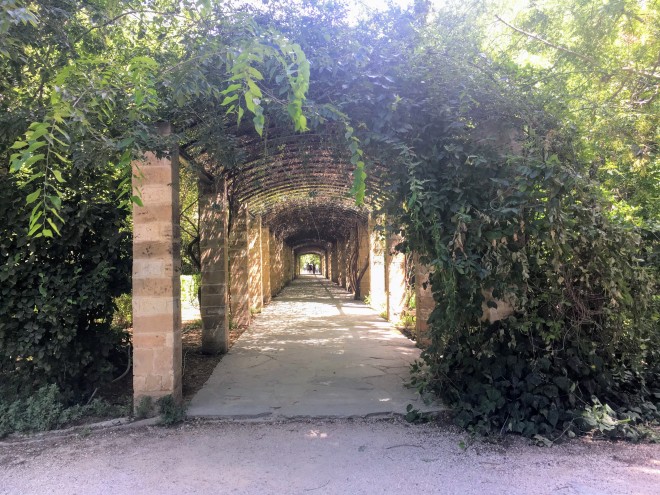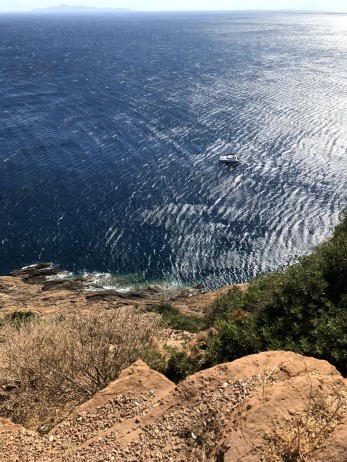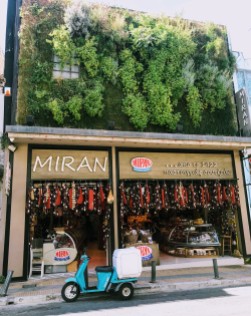I’ve been anxious to get to the island part of our trip, as it was the highlight and the part for which I had most planned.
Our plane for Santorini didn’t leave until 7:40 p.m., so our airport transfer wasn’t scheduled until 5:15 p.m. We checked out and stowed our bags in the luggage locker on the lower level of the hotel (€2 per locker). All of our bags fit easily into one locker.

By this time in the trip, the morning routine had been set: grab an espresso (€0.80) on the walk to the Sygrou-Fix metro stop or the Fix tram stop. That 5-day metro pass (€9) was the most sensible purchase of the trip. Today, we hopped on the tram and headed toward the all-marble Panathenaic Stadium, site of the first modern Olympic games, which it hosted in 1896. The entrance fee is €5 and includes a free audio tour for those interested.
All that marble really is quite something, and the view, if you climb to the top row of the stadium, is amazing, too.
The walk through the tunnel to the small museum and gift shop is nice and cool (temperature-wise and experience-wise).
We ended our time in Athens with lunch at Liosporos Bistro, a café in Iroon Square near the sweet and savory pie store we went to on the food tour. This area has the best street art, including a depiction of this woman-made river of nourishment.

I ordered hummus at the bistro, though by this time in the trip I’d learned that hummus is not a Greek food—I guess part of me knew that, seeing that it’s most common at Middle Eastern restaurants, but it didn’t fully hit me until I realized it wasn’t on hardly any menu. Perry got a coconut curry chicken dish here that was a favorite of his. We also got a chance to appreciate this wonderful staircase leading to the W.C.

A note on the W.C.: you do not dispose of tissue in the toilet here; instead, dispose of paper waste in the garbage can beside the toilet. I first encountered this system in China, but still had to retrain myself at times. Here’s a fact that’s a little more fun: Modernist writer Gertrude Stein used to call fellow Modernist William Carlos Williams (W.C. Williams) “Water Closet” Williams.
Across from Liosporos is a bar called Beer Time that specializes in beers from Greek microbreweries. We didn’t go here, but we did visit Hops Beer and Burgers by the Sygrou-Fix station earlier in the week to try some microbrews—we ended up with the Kirki Beer and the Chios House Ale, both of which were good.
After our late lunch, we made our way back to the hotel for one last rooftop drink before our pick-up. We made an Old Fashioned with the airplane bottles of bourbon and the single-serving Bittermilk Old Fashioned mixer we’d brought from home, bringing a little Kentucky toast to Athens. (We brought some extras, too, to give away as gifts if the situation presented itself. You can pack airplane bottles in your toiletry bag.)
We still miss that hard-to-beat rooftop view!
Our airport transfer arrived right on schedule, and we arrived to the airport and checked in without any trouble.
There are some areas to charge your phone or devices in the airport, but not many, so Perry ended up buying a portable charger, which he’d been wanting all week. It worked out well for us during the Santorini leg of the trip.
The airport bookstore also sales a “Vintage minis” collection that includes Swimming, an excerpt from Roger Deakin’s Waterlog, and Love, excerpts from Jeanette Winterson’s novels and memoir. Buy 2, get 1 free. These made for very portable reading throughout the week and after I got home–they’re roughly the size of an adult human hand (or at least the size of my hand).

The flight to Santorini was swift—under 45 minutes. Perry was thrilled that we could deplane at the back of the airplane. And, so, at 8:30 p.m., we stepped foot for the first time on Santorini, which we began to affectionately refer to as “our future home.” More on that soon.















































































 A Note on Packing
A Note on Packing


